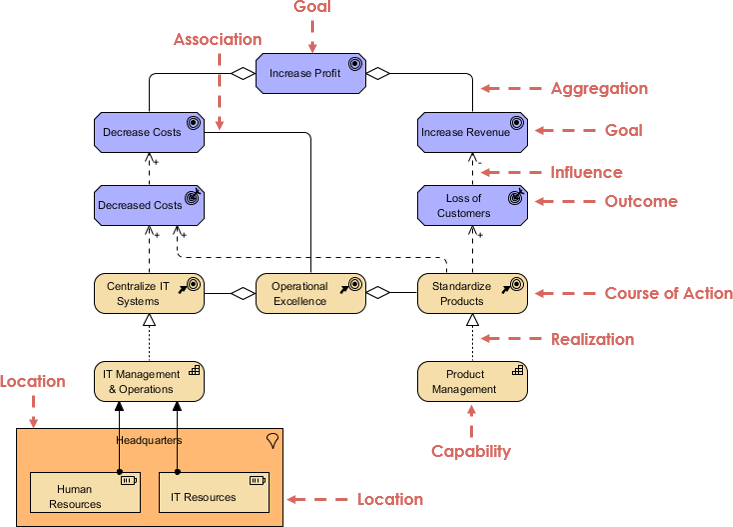The ArchiMate Specification, an Open Group Standard, is an open and independent modeling language for Enterprise Architecture modeling. This article provides an overview of the ArchiMate 3.0 Specification which is a major update to the ArchiMate 2.1 Specification and was published as an Open Group Standard in June 2016.
Visual Paradigm Enterprise Edition is a certified ArchiMate 3 enterprise architecture tool. It supports all ArcihMate 3 vocabulary, notation, syntax, and semantics.
Download NowNew features included in Version 3.0 include new elements for modeling capabilities:
The ArchiMate modeling language provides a uniform representation for diagrams that describe Enterprise Architectures, and offers an integrated approach to describe and visualize the different architecture domains together with their underlying relations and dependencies. The role of the ArchiMate Specification is to provide a graphical language for the representation of Enterprise Architectures which includes:
The design of the ArchiMate language started from a set of relatively generic concepts (objects and relations), which have been specialized for application at the different architectural layers of an Enterprise Architecture.
The most important goal for the ArchiMate 3 is that:
The new version of the language has been created to respond to a number of requirements:
The key changes in the new ArchiMate 3 specification are provided below.
The ArchiMate framework has been extended to include strategy and physical layers, as shown in figure below:

The strategy elements include elements for capability, resource, and course of action. The physical elements build upon the Technology Layer and add elements for modeling physical facilities and equipment, distribution networks, and materials.
Elements have been added to support modeling strategy, capability-based planning, and related domains. This supports the increased usage of Enterprise Architecture in supporting strategy execution, and is in line with approaches used in related standards, such as the TOGAF Framework and the Business Motivation Model.
Note that:
Outcome, course of action, capability, and resource are new elements introduced in the ArchiMate 3.0 Specification.

From the figure, you can see that:
The courses of action are realized by a number of capabilities:
The Technology Layer has been extended with elements for modeling the physical world; for example:
Note that:
All the elements shown in the example below, except for Path, are new in the ArchiMate 3.0 Specification, and Path has been renamed from Communication Path and its meaning extended to allow it to integrate with physical elements.

By reading the flow surrounded by dotted line in the figure above, you can see that an Assembly Line, modeled as equipment, and installed at a facility Manufacturing Plant, makes use of materials Pre-Assembled Circuit Board, Internal Antenna, and Plastic Case to produce material Vehicle Telematics Appliance.

By studying the elements surround by dotted line in the figure above, you can see that the appliance, initially located at the Manufacturing Plant facility, is subsequently transported to the facilities National Distribution Center and Local Distribution Center, making use of the distribution networks Overseas Shipping and Local Trucking. These distribution networks together realize the path Intermodal Freight.
A number of changes have been made to the language to improve its usability and consistency. These are summarized below:
An upper-level generic metamodel has been introduced to document the full structure of behavior and structure elements of the ArchiMate language presenting in the metamodel fragment as shown in the figure below. It defines these elements in a generic, layer-independent way.

Note That:
In ArchiMate 3, grouping and location are generic composite elements which has been updated. Composite elements can themselves aggregate or compose other composite elements.
The grouping element aggregates or composes concepts that belong together based on some common characteristic.
For Example, in the model below, the Grouping element is used to aggregate a conglomerate of two processes and an object that together realize a service (both with nesting and explicitly drawn aggregation relationships).

A location is a place or position where structure elements can be located or behavior can be performed. The location element is used to model the places where (active and passive) structure elements such as business actors, application components, and devices are located.

Changed the Notation for the Representation and Contract Elements
The notation of representation and contract has been changed to differentiate these from deliverable and business object, respectively.
| Node Description | Changed Graphic Notation |
|---|---|
Representation
|

Example  |
Contract
|
 |
Deliverable
|
 |
Business Object
|
 |
An optional notation has been introduced to explicitly denote the layer of an element. A letter 'M', 'S', 'B', 'A', 'T', 'P', or 'I' in the top-left corner of an element can be used to denote a Motivation, Strategy, Business, Application, Technology, Physical, or Implementation & Migration element, respectively.

| Updated Relationship | Example |
|---|---|
Object Flow
|

|
Used by
|
 |
Directional Notation
|
 |
Influence relationship
|
 |
Junction
|
 |
A viewpoint in ArchiMate is a selection of a relevant subset of the ArchiMate concepts (and their relationships) and the representation of that part of an architecture that is expressed in different diagrams. A set of such viewpoints was developed based on practical experience. The following are examples of stakeholders and concerns as a basis for the specification of viewpoints:
Previous versions of the standard included an extensive list of viewpoints within the normative body of the standard, and the ability to define viewpoints to fit a particular situation. In Version 3.0, the description of the viewpoint mechanism has been improved, and the list of viewpoints has been placed in an informative appendix to make it clear that these are example viewpoints.
Try Visual Paradigm Enterprise Edition, an enterprise architecture software that features a powerful ArchiMate drawing tool, ArchiMate viewpoint management tool and TOGAF Guide-through Process.
Try it Free